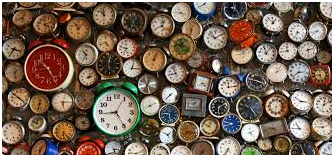Before the clock came into existence, people have several ways to tell time. In ancient time, people just rely on the sun to know what time it is. It is through the sundial. In fact, this is the oldest known instrument to tell time. It comes with markings on its surface for each daylight hour. Once the sun starts moving across the sky, a shadow will be casted on the sundial on another part of the sundial. To tell time, you just need to look which markings the shadow falls. Sundials were used at 1500 BC by the Egyptians.

Another way to tell time in the past is with the use of a water clock. This was the clock used by ancient Greeks. It is otherwise known as "clepsydra" where the flow of water is used to know the time. They come in 2 types; the outflow and the inflow. The outflow type uses a container filled with water. The water will slowly be drained slowly out from the container. The container is made with markings which help tell time by showing the level of water in it.
The mechanical clock was invented by the Chinese with the earliest model measuring 30 feet high. The first one of these types was invented in 723 AD by I-Hsing; a monk mathematician. In 1656, the pendulum clock was invented. It was Galileo's idea to use regulate the motion using a swinging bob to tell time in the 17th century. However, the credited invented of pendulum clock was Christiaan Huygens.
The watch that we have right now is an invention of Peter Heinlein in 1485. He is a clockmaker in Nuremberg, Germany, and a locksmith at the same time. However, clocks started to come out only on the market at 2002. They come in various forms like the analog clock, alarm clock, atomic clock, binary clock, balloon clock, bracket clock, the carriage clock and many others.
In 1656, the analog clock was invented. This is otherwise known as "Quartz Watches". They are different from pendulum clocks as well as ordinary watches. They come with gears inside designed to tell the seconds, minutes and hours. The hands are also swept around the clock face. However, the g ears of the clock are regulated by small Quartz crystal instead of a swinging pendulum or even a moving balance wheel.
The wristwatch, on the other hand, was first given to Elizabeth I from England by Robert Dudley in 1571. This was termed before as "arm watch". This used to be work exclusively by women. Men only used pocket watches. However, in the 20th century, men started to wear these types of time keeping devices too.
Today, clocks come in various shapes, colors and sizes. We now have skeleton mantel clock, digital clocks and many others styles of timekeeping devices. Others would wear it as a rings or necklaces too. But the most commonly used are clocks on mobile phones since almost everyone carries this type of gadget. Hence, it is easier to tell time these days.













